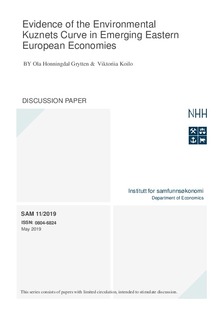Evidence of the Environmental Kuznets Curve in Emerging Eastern European Economies
Working paper

Åpne
Permanent lenke
http://hdl.handle.net/11250/2599731Utgivelsesdato
2019-05Metadata
Vis full innførselSamlinger
- Discussion papers (SAM) [657]
Sammendrag
This study aims to investigate the relationship of economic development, measured as economic growth, energy use, trade and foreign direct investment one the one hand and environmental degradation (carbon dioxide (hereafter CO2) emissions) on the other hand, in eleven emerging Eastern European countries during the period of 1990 to 2014.
The empirical results support a carbon emission’s Kuznets curve hypothesis for Eastern Europe. The current income level indicates that not every country has reached the turning point for CO2 emissions reduction goal.
In addition, the study proves a positive effect of foreign direct investment (FDI) on CO2 emissions in Eastern European countries. Also the results show that there is a negative effect of total energy consumption on environment as it increases CO2 emissions. Hence, there is a significant need of reforming the electricity markets that requires necessary improvement and attraction of investment, strong central political support, thorough preparation and continuous development.
Income elasticities for CO2 are positive for all 11 countries. The paper concludes that within the group Ukraine and Kazakhstan has the most sensitive change in economic growth in respect to its CO2.
It is expected that the innovative transition to a low-carbon economy offers great opportunities for economic growth and job creation. Technological leadership should be accompanied by the development and introduction of new technologies throughout Eastern European countries, hence, the paradigm of “sustainable development” should be considered. This requires the unification of the research, industry and financial sectors, as well as the support of state bodies.